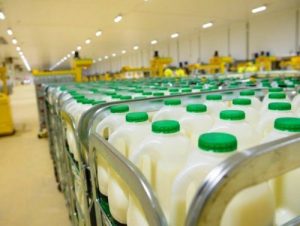Interest rates rise for fifth consecutive time

Interest rates rose again today as the Bank of England’s Monetary Policy Committee (MPC) voted for the fifth consecutive increase in the cost of borrowing since December.
The rate increased by 0.25% to 1.25%.
MPC members voted by 6-3 for the increase. Three members preferred a higher 0.5 per cent hike.
The central bank is fighting to rein in soaring inflation, which experts predict could last until the middle of next year, with rampant price increases in food forecast to hit 15% this summer.
Meat, cereals, dairy, fruit and vegetables are expected to be the worst affected due to the war in Ukraine and production lockdowns in China.
The Ukraine conflict has also sparked an unprecedent surge in the cost of fuel and energy which is crippling household budgets for millions of people.
The last time UK rates exceeded one per cent was in 2009, in the aftermath of the 2008 global financial crisis.
The UK’s Consumer Prices Index (CPI) rose to nine per cent in the 12 months to April 2022, up from seven per cent in March, with expectations it could reach 14% by October, when energy watchdog Ofgem is predicted to increase the energy price cap once more, adding hundreds of pounds to domestic and business energy bills.
However, the MPC said today that it expects inflation to rise to slightly above 11% in October.
The Bank of England’s target inflation rate is two per cent.
There was further gloomy economic news earlier this week when the UK’s economy unexpectedly shrank by a monthly 0.3% in April, adding to fears of a slowdown, or even recession.
Economists had expected gross domestic product (GDP) to grow by 0.1% in April from March.
Yesterday (June 15) the US central bank increased interest rates by three-quarters of a percentage point to combat inflation – the sharpest hike in 28 years.
Laith Khalaf, head of investment analysis at investment platform AJ Bell, said: “The Bank of England is playing a game of slowly, slowly catchy inflation, rather than the shock and awe tactics being employed across the Atlantic.
“Despite the UK starting to tighten monetary policy first, interest rates are now higher in the US. Markets will no doubt seize on this as a sign the Bank of England has bottled it, but an incremental strategy allows the rate setting committee to observe more data as it comes in, and fine tune its approach as circumstances dictate.
“The US economy also has more long term fixed mortgages than the UK, which makes interest rates across the pond a blunter policy tool, so the Fed has to create a bit of extra bang to have the same effect on a buck.”
He added: “No-one should labour under the misapprehension that interest rate rises are going to do anything about eye-watering levels of inflation in the short term. Our inflationary problem is being driven by a supply shock to energy markets stemming from the conflict in Ukraine, and the ensuing sanctions, and no number of interest rate rises will solve that problem. What the Bank is trying to do is head off second order inflationary effects becoming ingrained in the system and taking on a life of their own.
“The Treasury and the Bank of England are effectively playing the role of good cop, bad cop with UK consumers. On the one hand, the Chancellor is giving away billions of pounds in helicopter money to help ease the cost of living crisis, while at the same time the Bank of England is cranking up the pressure on household finances by increasing borrowing costs.
“Consumers probably won’t be best pleased to find that some of the fiscal giveaways they have been handed by the Chancellor are going to be gobbled up by higher interest rates. But if the Bank had failed to take any action, the pound would have come under further pressure, which adds to the cost of living crisis by pushing up the price of commodities priced in dollars, especially fuel. It would also increase the chance that inflation becomes embedded in the system and lasts for longer.”
He said: “The pandemic has hobbled the Bank of England though, because so many people have left the workforce or switched occupation. There are currently 1.3 million job vacancies in the economy, and extremely low levels of unemployment. The result is a clamour for staff in some industries, which has resulted in an eight per cent jump in private sector wages in the last year.
“While businesses may have an eye on the increasing cost of servicing their debt, for many their more pressing concern is having enough staff to open the doors and keep the tills ringing. The Bank may find that the huge dislocation in the labour market means that pressing down hard on the brakes has a more limited effect on wage increases than desired.
“Unfortunately, the mechanism by which tighter monetary policy works is very much a stick rather than a carrot, and that means inflicting considerable pain on consumers and businesses, who are already watching their costs escalating at a frightening pace.

Laith Kalaf
“Higher interest rates should also eventually serve to cool the housing market, as the impact gradually feeds through into mortgage affordability. Base rate is now expected to hit three per cent as we enter next year, so we are really only beginning to feel the burn of the Bank’s tightening cycle. Hopefully by then we will at least be starting to see inflation cooling, though that is clearly dependent on energy prices not rising further.
“Ultimately, the risk is that the combination of the energy price shock and rising interest rates leaves the UK in recession, having only just climbed back to pre-pandemic levels of economic activity.”
The Federation of Small Businesses (FSB) policy and advocacy chair, Tina McKenzie, said: “This latest rise illustrates something every small business owner will be acutely aware of: Rising costs are running out of control, and the operating environment for small firms is tougher than it has been for some time.
“The increase will make access to finance for small firms more expensive. This makes announcing a successor to the Recovery Loans Scheme, which ends later this month, even more important.
“FSB figures show finance application approvals drying up, so banks must promote the new scheme in good faith. And if we see a credit crunch following, as we did in 2008, having a scheme like this from the British Business Bank already up and running could be crucial, to combat the recession and protect small businesses from going under through a lack of cash.”
She added: “The Bank of England recently used the word stagflation in connection to the current economic crisis, which is noteworthy and deeply worrying. Low growth coupled with high inflation will be a death knell to countless small businesses. This is a scary moment. It’s hard to overstate how devastating the current spiralling inflation levels are, for businesses and consumers alike, and the longer the situation goes on, the more the damage compounds.”
Accountants Mazars claims UK businesses face an immediate increase in interest payments of almost £1bn following the rise in interest rates.
Analysis of Bank of England data by Mazars shows UK businesses are currently paying £11.2bn annually in interest payments on floating rate debts that are likely to be immediately impacted by an interest rate rise. Businesses that have to refinance their fixed-rate debt will be hit by the rate rise later.
With rates rising by 0.25%, annual interest payments on business lending will increase to £12.1bn almost overnight.
Further increases in the base rate would have a yet more dramatic impact. If interest rates were to rise to two per cent, interest payments for businesses would rise by a further £3.7bn to £14.9bn.
Mazars says that with business insolvencies already rising, increases in the cost of borrowing are likely to force more companies to close their doors.
Rebecca Dacre, partner at Mazars, said: “The number of businesses closing down is accelerating and that’s while interest rates are still at low rates historically. With every rise in the base rate, debt burdens increase and more businesses will go under. The squeeze on costs is relentless and businesses are running out of places to turn.”
She added: “It’s worth remembering that it’s not only consumers that are facing a cost of living crisis. Businesses, too, are seeing their costs rise sharply and those that sell direct to consumers are being hit by people cutting their spending. Experts have been warning there would be a rise in the number of business insolvencies and every rise in costs makes it more likely.”








